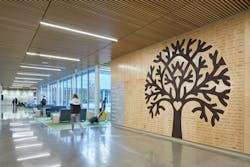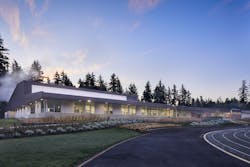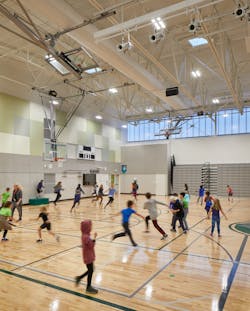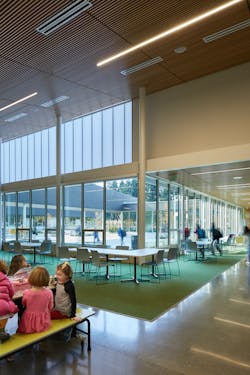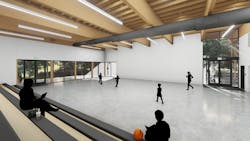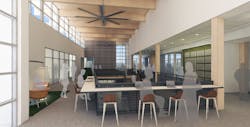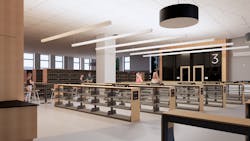EDUCATION LIGHTING | Simplify school lighting systems with LLLC (UPDATED)
Comfortable lighting and reliable functionality create a viable space for public buildings, such as schools, that serve people with a variety of experiences and needs.
Recently, the team at TFWB Engineers was charged with retrofitting a hybrid gym and auditorium space at a western Washington K–8 school, which serves 650 students and is home to a district’s deaf and hard-of-hearing program.
The new 80,000-square-foot facility engages the Madrona School’s valued outdoor environment by embracing exterior circulation, eliminating hallways, and maximizing spaces for learning and playing. Biophilic or nature-inspired design in schools has been shown to positively impact the wellbeing and performance of all students. That effect is multiplied for students who are deaf or hard of hearing, as they depend heavily on visual cues for learning and to feel safe and comfortable in various settings.
The entire project team wanted to deliver a system that would respond to the student’s activities, so I turned to networked controls in the project design specification. The benefits of luminaire-level lighting controls (LLLC) were immediately clear to me. The technology offers levels of granular lighting control and system-wide responsiveness previously impossible, as well as clean, wire-free installation and function.
The challenge lay in helping other project stakeholders — including contractors, building owners, and school district administrators — understand the technology and unknowns. I would have to clearly communicate the pros and cons to convince them, but it would be worth it, since LLLC would allow us to maximize the functionality of flexible digital lighting and controls technology.
LLLC simplifies and saves money
While much of the school’s lighting design — including non-LLLC controls and significant daylighting — was already in place, I recognized LLLC was the ideal recommendation, although it was still fairly new to me and my industry colleagues. As suspected, school administration officials initially demurred, with concerns stemming mainly from a lack of familiarity with the technology and questions about cost and maintenance.
Like many designers, I have a concrete understanding of the hidden functionalities of wireless technology, but for those outside our industry, the physicality of wiring offers a sense of familiarity. Non-industry stakeholders need to experience an LLLC-lit environment firsthand, because adopting new technology feels risky. They need to witness the benefits to overcome their resistance to new approaches. My method of presenting LLLC in design projects is three-fold: First show the beauty; explain end user controls; and outline the costs and savings involved.
By deploying LLLC, the ability to illuminate only where and when needed leads to immediate energy savings. Furthermore, eliminating wires and conduits can significantly reduce installation labor. Case studies have shown that labor can drop from an average of 18 hours to just four in a typical classroom lighting installation, with similar savings in low-voltage wiring costs. Additionally, wireless LLLC creates a cleaner aesthetic by condensing multiple sensor functions into a single integrated sensor per fixture, as it reduces wiring infrastructure.
Budget is a central concern for many of the projects we work on, especially for public institutions such as schools. The initial cost lift for the luminaires with sensors is typically offset by the more significant labor and wiring savings, so LLLC offers the most value over time. Furthermore, LLLC helped Madrona School meet Washington State’s progressive energy codes, saving time and effort for administrators tasked with code compliance while ensuring that local buildings are doing their part to conserve energy and protect natural resources.
For our stakeholders, the work pays off in the form of a beautifully lit area that can be programmed and easily reprogrammed with a tablet. The flexibility offered by Madrona School’s new LLLC high-bay fixtures means that students on one end of the space can play a sharply illuminated pickleball match, while on the other end, another group can arrange scenery and set lighting levels for a musical performance.
Early successes evolve standard practices
At its core, lighting is a sensory experience. An environment illuminated to meet its inhabitants’ needs supports the body and the brain in the same way that music performed in a suitable acoustic environment does. I have witnessed the childlike wonder of stakeholders touring a space designed with LLLC, and their response is simply, “Can we do this, too?”
Based on the positive reception to the Madrona project, our team has proceeded to universally specify LLLC for new projects as shown here. This includes a multifunctional communal area for the Suquamish Tribe’s Chief Kitsap Academy, a new administration building for the Bellingham School District, and the new Mount Vernon Library Commons — all in Washington State. These projects will benefit from LLLC functions for embedded occupancy, daylighting, and daylight sensing as well as the aesthetically pleasing, wire-free views of wood elements and the smooth lines of continuous load path construction — not to mention reduced costs and increased future-proofing.
The less-is-more appeal of LLLC — combined with flexibility, cost savings, and the growing list of exemplary buildings — is reducing the need to sell stakeholders on the technology. Instead, we can focus on collaborating with them to use LLLC as the springboard for the present and future of their buildings. The benefits are not limited to lighting; they extend to the system’s ventilation/HVAC and security capabilities, issues of paramount importance for our communities.
During my decade-plus experience, I’ve always believed in the power of lighting — the beauty and function it brings to a space. Now, a new chapter is unfolding and it’s exciting to see how these advanced lighting and controls can enhance the community’s health and happiness in educational environments and other public buildings.
APRILLE BALANGUE is a principal engineer at Travis Fitzmaurice Wartelle Balangue Engineers, based in Seattle. She collaborates with BetterBricks, a commercial resource of Northwest Energy Efficiency Alliance (NEEA), as a consultant in lighting design and controls.
*Updated Sept. 21, 2023 for image caption clarifications and BetterBricks link.
Follow our LinkedIn page for our latest news updates, contributed articles, and commentary, and our Facebook page for events announcements and more. You can also find us on the X platform.
Aprille Balangue
APRILLE BALANGUE has been a principal engineer at Travis Fitzmaurice Wartelle Balangue Engineers since 2007. She has 15 years of experience in electrical design including power distribution, communications systems, audio/visual, fire alarm, security, access control, CCTV, and architectural lighting applications. Balangue has served as project engineer and project manager on numerous educational, multi-use, and community projects where she focuses on delivering smart, sustainable solutions for learning, working, and living environments.
